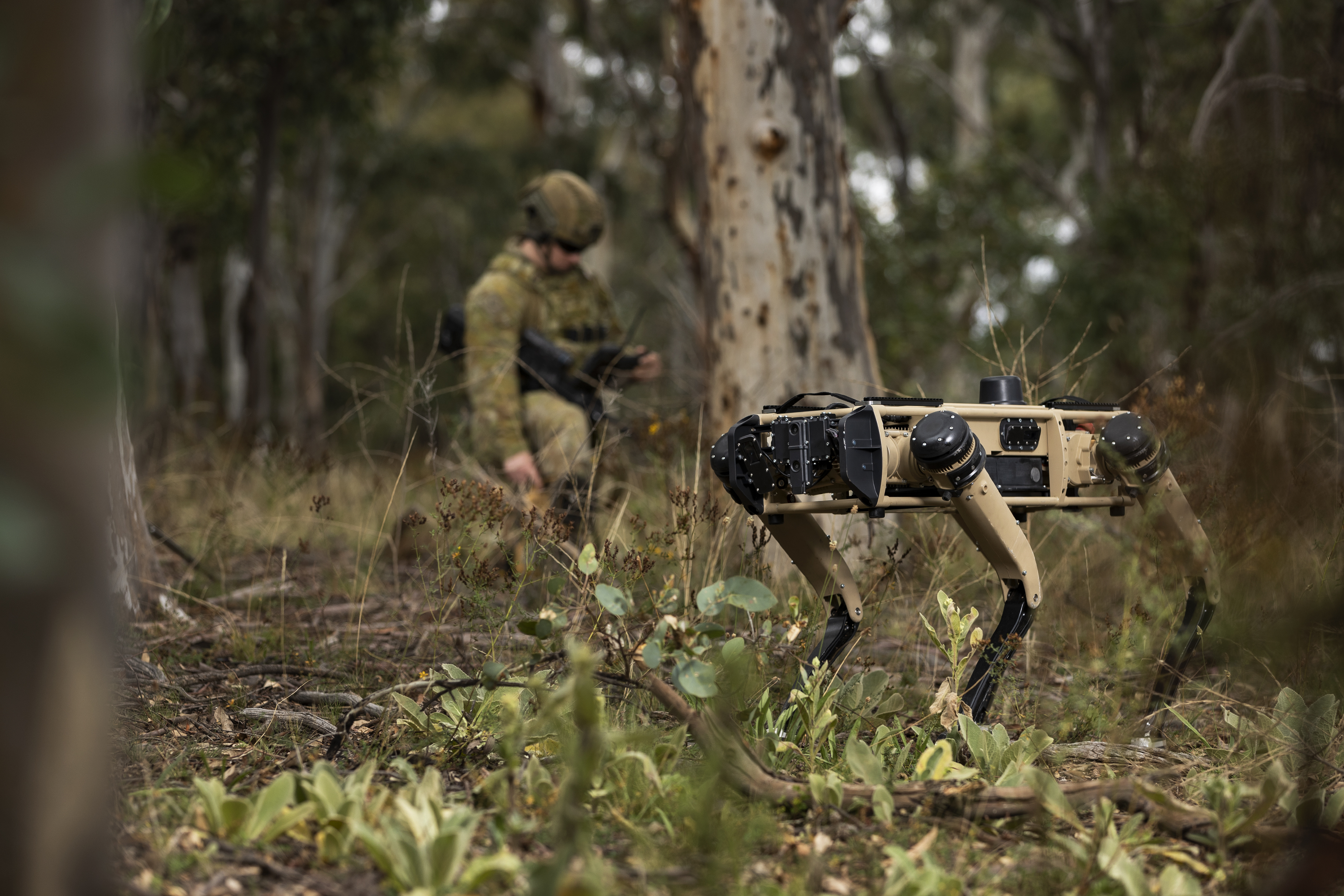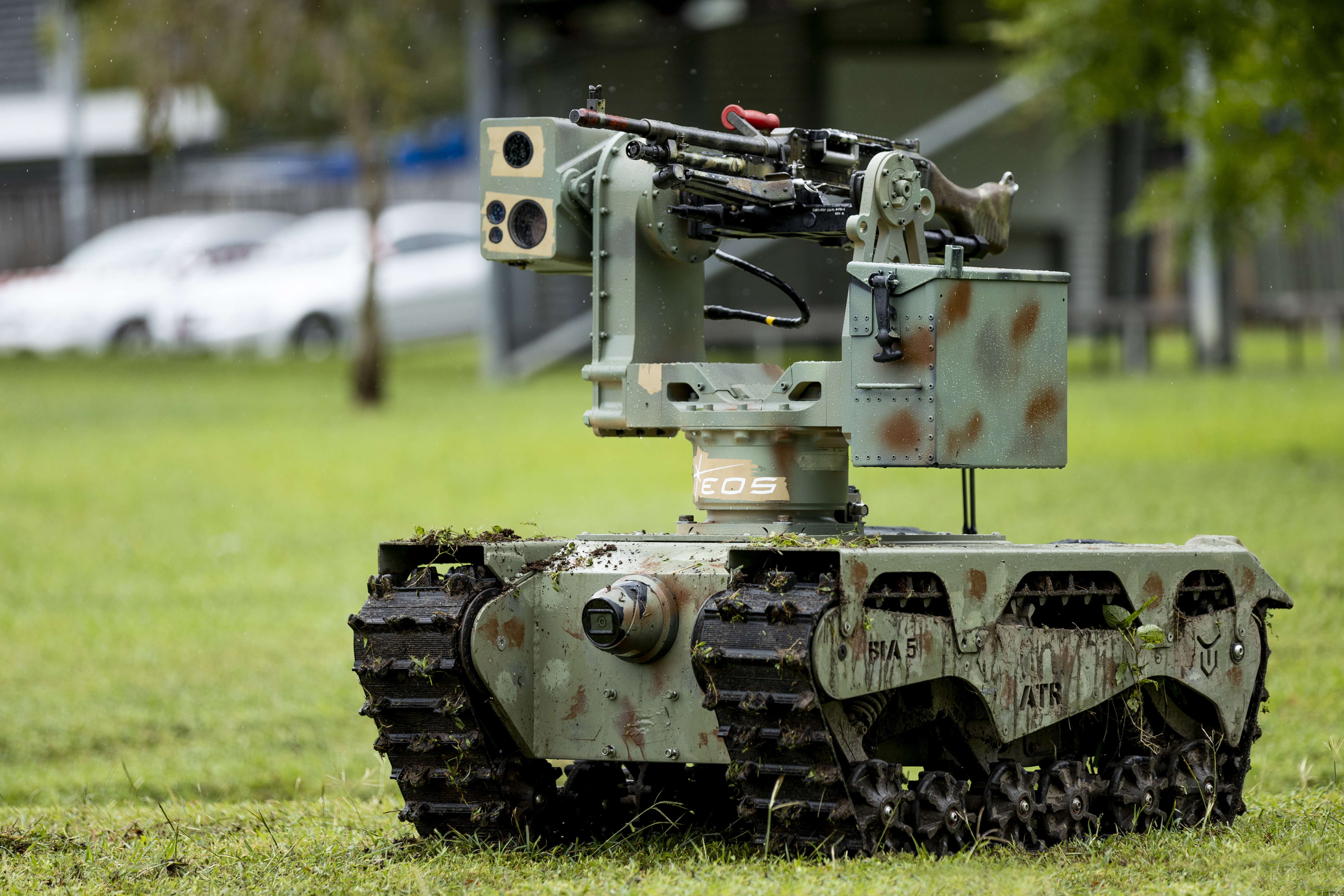The Australian Defence Force is modernising rapidly. Emerging technologies and operating methods present a range of opportunities to significantly enhance capability. To ensure this modern force is appropriately sustained into the future, the ADF’s logistics capabilities cannot afford to be left behind. The Army Logistic Training Centre Fiction Competition encouraged writers and multimedia artists to visualise the future of logistics in the 2025 - 2040 timeframe.
‘Since all progress is necessarily a matter of omitting old ways and adopting new, the first essential of leadership is a sublime indifference to precedent’. Robert Quillen
It’s the year 2033 and Army has completed autonomous modernisation, including integration of first-generation artificial intelligence (AI) to create an Internet of Military Things. Now an amphibious deployment of mechatronic forces is in progress. Dronecraft Carriers approach a ‘drone release zone’ preparing to deploy tactical resupply quad-copters. Combat escort drones armed with thermobaric missiles track at high-altitude above the unmanned air-transporters providing them with security overwatch. The dronegistics mission is to resupply a Mechatronic Task Unit (MTU) human-machine combat team, which deployed ashore from an Amphibious Task Group to clear hostile autonomous machines.
Dronecraft Carriers were developed to rapidly convey swarms of short range tactical combat and logistic support drones or robot action teams to forward operating areas.
The drone projection platforms can be launched from a ship at sea and employ multipath small satellite control networks for beyond-line-of-sight communications and drone telemetry transmission.[1] The nimble quad-copters carry packaged combat supplies for the MTU, which includes ammunition pods, battery packs and robotic spare-parts for the sentient war machines, including combat rations and water for MTU command node soldiers. The recoverable quad-copters are engineered to be highly effective logistic enablers, as they can land anywhere an MTU is operating and present as fleeting targets if observed.
Before the drone-carriers disgorge their fleet of sustainment drones, they are struck by surface-to-air anti-drone missiles from a detachment of enemy ‘Missilebots’. The ‘Missilebot Detachment’ is swiftly dispatched by thermobaric missile strikes from the responsive combat escorts. But it is too late as the doomed drone-carriers fall in jagged pieces from the sky, after smart tandem-warhead missiles evade their defensive counter-measures. The tactical situation has changed with the revelation that threat forces manoeuvred air defence systems near the main supply corridor. But back in the human-led Logistics Command Post, a ‘Logistic Watson’ AI mission support system is already computing alternate task parameters for an autonomous ground convoy and logbotics mission. The automated, human-reviewed tactical calculus includes options for a logistic deception plan, but this is omitted from the final mission design. Within two hours a convoy of electric autonomous trucks and logistic robots, including soldiers wearing exoskeletons and head-up display helmets snakes its way along the secondary supply route towards a forward Distribution Point (DP).

The smart convoy consists of Overlander wheeled vehicles that were converted to zero emission, all-electric drivelines and self-driving capability during their mid-life upgrade program. The convoy is escorted by autonomous security vehicles equipped with anti-drone Phalanx mini-gun systems. Every vehicle is also configured with Drone Electronic Counter-Measures (DECM) as a means of close defence. The DECM systems operate similar to improvised explosive device (IED) counter-measures by disrupting electromagnetic command signals, which cause drones in flight to crash once they enter the DECM protective envelope. However, kinetic effects from a millimetric radar controlled Phalanx are still essential, as with advances in cryptography and autonomous technology, DECM is not always effective against some classes of drones. As the convoy reaches the half-way point they approach a defile consisting of a sharp bend in the road, and a series of small wooded features with steep re-entrants. A troop of disabled armoured vehicles blocks part of the narrow road, so the autonomous trucks are temporarily halted while their self-driving sensors scan the area and algorithms plot a safe path around them.
The incapacitated armoured vehicles led the initial advance inland following amphibious lodgement, but their human-crewed turrets proved no match for the autonomous electric mini-tanks they encountered at the treacherous defile. Artificial intelligence enabled gun turrets on the stealthy mini-tanks calculated and executed firing solutions several times faster than human operated weapon turrets, so the legacy armoured vehicles in the advance guard force were quickly neutralised. Suddenly, a swarm of hostile quad-copters silhouette over the nearest hill and vector towards the convoy’s lead vehicle. The forward Phalanx defence system quickly unleashes a storm of accurate mini-gun fire that decimates the drone swarm. However, it is only a diversion and a drone ambush ensues when another fast-moving swarm attacks from the right flank.
Fortuitously, both front and rear convoy Phalanx systems can be brought to bear on the larger swarm of assault drones, so this threat is swiftly wrecked by withering automated cross-fire. During the counter-drone battle, human leaders in the Land Force Command Post plan ahead by leveraging a ‘Combat Watson’ AI mission support system. Then to ensure the smart electric convoy achieves its sustainment mission, a considered tactical decision is made to secure the defile with rapid airborne insertion of a ‘Para-Mech Team’. Para-Mechs come in multiple variants and are also deployed by drone carriers, but insert in Drop Pods, which once released, free-fall most of the way before activating an airbrake to arrest the velocity of their descent just prior to ground impact. Rapid insertion pods also feature crumple zones and internal airbags to further absorb impact forces on the robot passengers. So Para-Mech robots land then emerge ready to engage in mechatronic combat. This type of autonomous system is configured as a ‘canine’ four-legged assault robot, with a 90mm semi-automatic recoilless gun mounted on its back. The gun fires either multi-explosively formed penetrator or nano-explosive smart munitions. They track threats via a multi-spectral targeting system and an acoustic sensor suite. Moreover, the Para-Mechs are known as Cujo’s after the 1983 horror film about a wild dog. Except these lethal smart bots move in pairs and hunt in packs of eight to decisively defeat autonomous threats. Cujo’s are a ‘St Bernard Class’ robot (inspired by the dog breed in the film). But its canine chassis can also be configured for logistic support functions. The sustainment variants are known as Beethovens after the 1992 comedy about a friendly St Bernard.
The drone-carrier flies at low-level to avoid dangerous Missilebots, then on approach to the defile it pitches up at high angle and catapults eight Drop Pods on an arched trajectory towards the hill’s forward slope. Airbrakes deploy and expendable pods crash to earth in quick succession. Combat-ready Cujo’s rally then scramble with powerful alloy legs to the crest of the hill complex. They soon encounter enemy Sniper Bots waiting in ambuscade to disrupt the resupply convoy. A Cujo is quickly incapacitated in the surprise meeting engagement by an accurate sniper shot, before the other Cujo’s ‘cry havoc’ and obliterate the robotic assassins with a cannonade of nano-explosives. So the defile is efficiently secured by robotic ‘wardogs’ and the human-machine logistic team proceeds with its vital DP mission.

Enroute the convoy passes remnants of a ferocious mechatronic battle; destroyed mini-tanks, crashed drones and wretched robot body parts are strewn beside the road. After arriving at the distribution point (DP), Mechatronic Maneouvre Teams from the MTU start cycling through the digitalised reconstitution process. Also a human soldier wounded by shrapnel undergoes minor surgery with a robotic surgeon in an autonomous ambulance. The wounds are cleaned, sealed and anti-biotics administered, allowing the patient to ‘soldier on’. But for patient reassurance, the autonomous medical procedure is remotely supervised by a human surgeon on a ship at sea, via satellite video link to the robot surgeon’s real-time audio-visual display. However, some heavily damaged combat robots were not as fortunate as their human counterparts and are salvaged by an autonomous recovery vehicle for robot parts recycling. Autonomous action in the digital DP is also where the small satellite communications constellation is high-value, as low-latency data-transfer is accessed by all the robotic systems. A cyber-secure, satellite supported wifi bubble is generated in the smart sustainment point, which automatically analyses robotic system diagnostics and updates their artificial intelligence software with new security patches and lines of mission code.
Human logistic soldiers wearing solar-powered exoskeletons effortlessly install heavy battery packs and ammunition pods on the combat team robots. Maintenance actions occur concurrently as repairbots replace damaged mechatronic components with 3D printed, modular spare-parts or recycled components from robots damaged beyond repair. Additionally, MTU armoured vehicle electric drivelines are recharged in minutes via supercharger systems carried in the convoy. MTU assigned Beethovens also attend the smart DP and refurbish stocks of combat supplies hauled on their back-racks for first-line logistic support. The resupply occurs expeditiously as all logbotics systems function via a Master Logistics Algorithm, which enables them to reason and adjust their tempo as required. While the dronegistics air-resupply failed, automated convoy defence contrivances and the logbotics digital DP was a tactical success. Thus mechatronic sustainment principles and technology had proven both agile and adaptive in relation to the evolving tactical situation. Accordingly, the MTU is postured to continue mechatronic manoeuvre and the smart convoy can redeploy to prepare for subsequent sustainment missions. Therefore, Army’s autonomous modernisation strategy crafted fifteen years earlier proved to be valuable foundation work, as it realised survivability dividends in an autonomous hyperwar future.
Prescient futures planners were not constrained by ‘immutable old methods’ of operating and embraced utopian artificial intelligence technologies, including innovative opportunities that emerged during the Fourth Industrial Revolution. 5th Generation Army force structure deliberations were initially protracted, but technological change occurred sooner than forecasters anticipated. Auspiciously, an indifference mindset to both ‘precedent’ and polemic stakeholder nostalgia among planning staff and strategic leaders was the genesis for implementing the Laws of Modernisation. However, isolated instances of myopic miscalculation did occur in balancing the enterprise design equation, such as retaining human-operated turrets in selected variants of combat systems. Mechatronic combat confirmed that human reaction speeds could not compete with artificial intelligence enabled robotic and drone systems. So blending legacy military capabilities with autonomous force structures was recognised as a strategic risk. Consequently, feckless capability needs across the Land Combat System were omitted and cogent new ways were fully embraced by the institution, albeit at substantial cost. Importantly, strategic change was executed only after extensive test and evaluation, which featured unassailable cyber security protocols as a top priority. Lastly, the inventive theories of dronegistics and logbotics emerged as transformative lexicons of mechatronic sustainment doctrine, which underpinned advances in the delivery of smart logistics.









